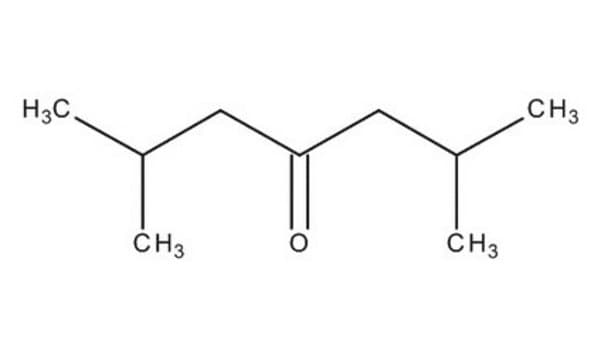537691
2,6-Dimethyl-4-heptanone

technical grade
Sinonimo/i:
Diisobutyl ketone, Isovalerone
About This Item
Prodotti consigliati
Grado
technical grade
Densità del vapore
4.9 (vs air)
Tensione di vapore
1.7 mmHg ( 20 °C)
Temp. autoaccensione
745 °F
Composizione
Limite di esplosione
0.8-6.2 %, 100 °F
Indice di rifrazione
n20/D 1.412 (lit.)
P. eboll.
165-170 °C (lit.)
Densità
0.808 g/mL at 25 °C (lit.)
Stringa SMILE
CC(C)CC(=O)CC(C)C
InChI
1S/C9H18O/c1-7(2)5-9(10)6-8(3)4/h7-8H,5-6H2,1-4H3
PTTPXKJBFFKCEK-UHFFFAOYSA-N
Cerchi prodotti simili? Visita Guida al confronto tra prodotti
Categorie correlate
Descrizione generale
Applicazioni
Avvertenze
Warning
Indicazioni di pericolo
Consigli di prudenza
Classi di pericolo
Flam. Liq. 3 - STOT SE 3
Organi bersaglio
Respiratory system
Codice della classe di stoccaggio
3 - Flammable liquids
Classe di pericolosità dell'acqua (WGK)
WGK 3
Punto d’infiammabilità (°F)
120.2 °F - closed cup
Punto d’infiammabilità (°C)
49 °C - closed cup
Dispositivi di protezione individuale
Eyeshields, Gloves, type ABEK (EN14387) respirator filter
Certificati d'analisi (COA)
Cerca il Certificati d'analisi (COA) digitando il numero di lotto/batch corrispondente. I numeri di lotto o di batch sono stampati sull'etichetta dei prodotti dopo la parola ‘Lotto’ o ‘Batch’.
Possiedi già questo prodotto?
I documenti relativi ai prodotti acquistati recentemente sono disponibili nell’Archivio dei documenti.
Il team dei nostri ricercatori vanta grande esperienza in tutte le aree della ricerca quali Life Science, scienza dei materiali, sintesi chimica, cromatografia, discipline analitiche, ecc..
Contatta l'Assistenza Tecnica.









